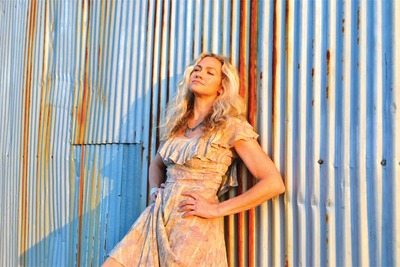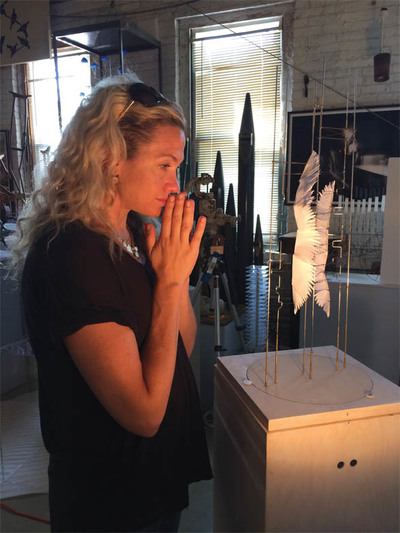Consenses: Festival of the Senses

Sally Taylor. Photo: Heidi Legg.
SALLY TAYLOR HAS ORGANIZED an epic game of artistic Telephone. The result, Consenses, a wildly ambitious cross-disciplinary project, may not begin and end with the same idea, but the byways and detours along the way are studded with inspiration and delightful twists of communication.
Taylor started, she says, with photographs that evoked “nature and home, and a prelinguisitic relationship to space and nature.”
She passed each photograph to a songwriter, who wrote a song inspired by the image. Each song went to another artist and soon painters, sculptors, perfume makers, poets, choreographers and more were part of a chain. Eight of the chains, arrayed on stage sets, opened at the Grange Hall on Martha’s Vineyard in August as Consenses Festival of the Senses. In September, the project travels to Cambridge and Somerville, and Taylor hopes to take it on the road.
The seeds may have been planted for Consenses back when she was a tiny thing, just perceiving the immensity and wonder of the world, not even talking yet. Before words got in the way.
“Language can be threatening,” Taylor says. “If I describe my belief system, you might think, ‘well, that’s not what I believe.’”
But the magic of a good painting, a moving song or a mystical dance performance is in the imagery.
“With image, we have this bottom-up process, where we can make our own sense of something,” Taylor says. Can she describe her own prelinguistic experience?
It’s midsummer and Taylor is standing amid the stage sets as they’re being built during the Consenses dry run at the University of Massachusetts, Boston. She looks around at the art, the listening stations with headphones, the video monitors and more.
“This!” she says. “The beauty of this. It redefines it, recolors it. But this is it.”
Only some of the art is up. There’s a jug of tea that a tea maker conjured to stir olfactory reverie, and one of sculptor Mark Cooper’s serpentine shelving units bursting with his offbeat, colorful vessels and photographic imagery. But at this point, as drills sing, saws roar and sawdust flies, Taylor has yet to see the whole of what she has wrought.

Chain #7’s set design by Cristina Todesco, featuring artwork l. to r. photo by Alison Shaw; painting by Hendrik “Henk” Gringhuis; headphones to listen to Isaac Taylor’s music; video performance of Alexandre Lane’s dance; perfume scent strips of Meredith Smith’s fragrance; sculpture by Thomas Sayre.
Which is, in a way, fitting. Her inspiration for Consenses was the old Indian fable about the blind men and the elephant. One man stroked the elephant’s tusk and proclaimed it a spear. Another tugged its tail, and said, “No, this is clearly a rope.”
“We all have a piece of the truth but you need to work together to see its larger nature,” Taylor says.
The process has been blind, as well. None of the artists were told who created the work that each was given for inspiration. Cooper got a video with a song.
“I was taken by the music,” he says. “I thought of first love, illicit love, love you might never see again.”
After he finished his sculpture, Taylor told him the song had been written by Sugarland’s Jennifer Nettles.
“I realized that if I’d known that, I would have used different photos,” Cooper says. “It would have been more country crossover.”
It’s hard to say how clear the through-line will be in each chain. Cooper speculates that the effect of the accumulated works of art will be like that of a collage or an assemblage.
“It’s nonlinear,” he says. “And it triggers something in viewers’ brains different than a linear story.”
Taylor, probably best known as a songwriter and musician, is the daughter of Carly Simon and James Taylor. She knows a lot of artists but she also made a lot of cold calls. Her parents contributed songs. So did Jimmy Buffett. Other big names on the list include filmmaker Wes Craven, writer and poet Susan Minot, and photographers Peter Simon (Taylor’s uncle) and Claire Rosen, and sculptor and public artist Mags Harries.
Not every artist involved has an international career. Boston Sculptors Gallery appears to be a hotspot for Taylor, who lives in Cambridge. Participating artists with ties to that gallery include Harries, Hannah Verlin, Kim Bernard, Eric Sealine and Dennis Svoronos.
In all, Taylor wrangled 140 artists and funded the project with an Indiegogo campaign and private donations. Those artists whose works don’t appear on one of the eight Consenses sets will be represented in chains available to experience on iPads.
Taylor handed choreographer and dancer Annmaria Mazzini a piece of instrumental music that Mazzini says she wouldn’t ordinarily use in her work. She told Mazzini she could choreograph it for a dancer or do the dance herself on film. Mazzini, who was nine-and-a-half months pregnant at the time, chose to do it herself.
“It was a quick turnaround time,” Mazzini says, and that worked to her advantage—she was about to pop. “Sally wanted you to go with your first impression, to not plan, but have your work be a reaction to the material.”
Mazzini, a planner, planned ahead anyway. Then, when she got the music, (by Taylor’s brother, Ben Taylor, although Mazzini didn’t know that) she had to throw out her ideas.
“Once I got up and tried to put it into motion, I couldn’t do it, because I was bursting at the seams,” says Mazzini, a former principal dancer with the Paul Taylor Dance Company and artistic director of Mazzini Dance Collective. “I started improvising.”
“For me, the process became about letting go of the rules I’ve made for myself in my work,” she says. “At the same time … this being inside was controlling me. I was becoming the puppet. I was letting someone else influence the outcome.”
The dance and the music will be presented separately. In Taylor’s vision, the music is not integral to the dance but a response to it: If this music were movement, what would it look like?
When she was a girl, Taylor says, her mother taught her a game called Essences.
“We’d select someone in our head and people would ask metaphoric questions about the person’s essence,” Taylor remembers. “If this person were a color or a body of water—he would be green; he would be a spring well. Once the identity was revealed, a wonderful conversation ensued: ‘I see that person as a waterfall but you see him as a well.’ We could see our own perceptions.”
She looks around the installation-in-progress. “This is the grown-up version.”

Sally Taylor observes David Lang’s Courtship from Chain #17.
Behind her, set designer Cristina Todesco is preparing a space for work by photographer Alison Shaw, songwriter Isaac Taylor (Taylor’s cousin), dancer Alexandre Lane, painter Hendrik “Henk” Gringhuis (who died in March), sculptor Thomas Sayre and perfumer Meredith Smith.
There’s a lot to integrate in a single set.
“We see it all. We have to understand the common thread, what’s carrying the energy through each artist, and distill it down, to create a space and reveal the overall effect,” Todesco says.
This group, she says, “boils down to an overwhelming feeling of solitary meditation and yearning.”
From the seats of the McCormack Theatre at UMass, the Consenses dry run looks like a labyrinthine stage set. Standing in the middle of it, it’s more like an art installation, with many rooms and many sensory triggers. But it’s not intended to live on a stage, or in a museum or gallery.
“It just needs a big enough place to breathe,” Taylor says.
Painter Kara Taylor (who is not related to Sally Taylor but has known her almost all her life), also found a sense of longing in the song she was given. “It made me think of nighttime, the mystery of the night sky,” she says. She painted crows sitting on winter trees.
“I went into it very instinctively,” she says. “There’s a fine line: How much do you take from the other person and how much is your interpretation?”
Kara Taylor says she’s not surprised to see her friend Sally devise such an ambitious, wide-open project.
“She’s a really creative person,” says the painter. “She’s tried many different things. This is an amalgamation of all she’s done.”
As for the Consenses impresario, the process, which began more than two years ago, has been one learning curve after the next.
“I had to find a mentor for each medium,” Taylor says. “You can ask a painter to do this but not that. A perfumer does not provide an ingredient list. How do I get eight set designers?”
There have been glitches and moments of grace. A dancer got injured. But the master electrician, the technical director and the program manager agreed to work for just one salary.
“I don’t get to be in control. I just get to ride it as if it were an elephant,” says Taylor. “With no reins.”
Cate McQuaid is a critic for the Boston Globe.
